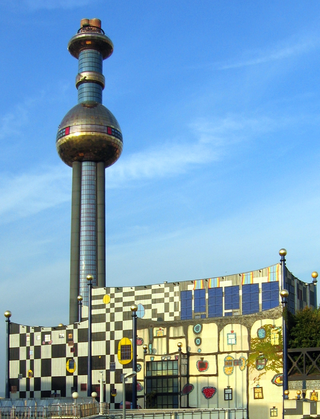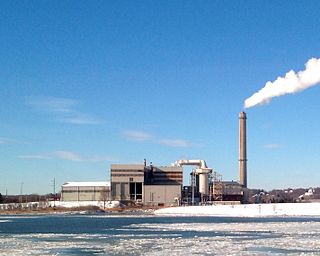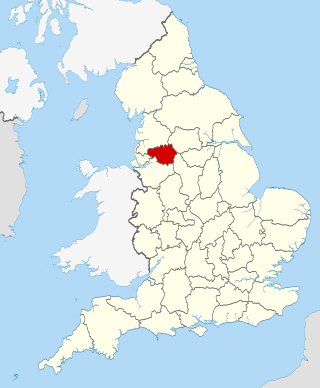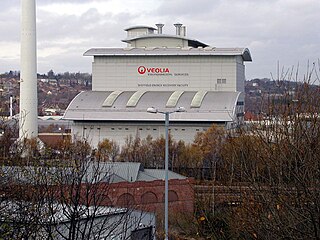Related Research Articles

Incineration is a waste treatment process that involves the combustion of substances contained in waste materials. Industrial plants for waste incineration are commonly referred to as waste-to-energy facilities. Incineration and other high-temperature waste treatment systems are described as "thermal treatment". Incineration of waste materials converts the waste into ash, flue gas and heat. The ash is mostly formed by the inorganic constituents of the waste and may take the form of solid lumps or particulates carried by the flue gas. The flue gases must be cleaned of gaseous and particulate pollutants before they are dispersed into the atmosphere. In some cases, the heat that is generated by incineration can be used to generate electric power.

A waste-to-energy plant is a waste management facility that combusts wastes to produce electricity. This type of power plant is sometimes called a trash-to-energy, municipal waste incineration, energy recovery, or resource recovery plant.
Articles related to waste management include:

The Greater Manchester Waste Disposal Authority (GMWDA) was England's largest waste disposal authority, responsible for the management and disposal of municipal waste from Greater Manchester. It dealt with 1.1 million tonnes of waste produced each year, from approximately 1 million households and a population of over 2.27 million in the metropolitan districts of Bolton, Bury, Manchester, Oldham, Rochdale, Salford, Stockport, Tameside and Trafford — though part of Greater Manchester, the Metropolitan Borough of Wigan administers its own waste disposal operations, however they were represented on the authority for administration purposes. The waste came primarily from household waste collections and 20 household waste recycling centres (HWRCs) provided and serviced by the GMWDA. It handled around 4% of the nation's municipal waste.

Waste-to-energy (WtE) or energy-from-waste (EfW) refers to a series of processes designed to convert waste materials into usable forms of energy, typically electricity or heat. As a form of energy recovery, WtE plays a crucial role in both waste management and sustainable energy production by reducing the volume of waste in landfills and providing an alternative energy source.

The Allington Quarry Waste Management Facility is an integrated waste management centre in Allington, Kent. It is the site of the Allington Energy from Waste (EfW) Incinerator. The incinerator is owned by FCC Environment as Kent Enviropower. The facility, which has involved an investment of over £150 Million, is able to process 500,000 tonnes per annum of waste and has the ability to produce 40MW of power. The facility takes non-hazardous waste from households and businesses in Kent and the surrounding area for recycling and energy recovery. Materials separated by householders are sorted and sent for recycling, with the remainder being used to generate electricity to power the facility and for the local supply network.

The Kirklees EfW is a major moving grate incineration plant in Huddersfield, Kirklees, England. The incinerator is owned and operated by Suez Recycling and Recovery UK who signed a 25-year contract with Kirklees Council in 1998 with an option to increase the time period to 2028. The plant is integral to the waste strategy and Unitary Development plan of Kirklees Council, treating 150,000 tonnes of locally generated municipal waste, which when incinerated, will produce enough electricity to power 15,000 homes. Only 136,000 tonnes of waste is actually incinerated, the other tonnages permitted are recovered materials such as metals and Incinerator bottom ash (IBA) and Fly ash.

The Sheffield Energy Recovery Facility, also known as the Energy from Waste Plant, is a modern incinerator which treats Sheffield's household waste. It is notable as it not only provides electricity from the combustion of waste but also supplies heat to a local district heating scheme, making it one of the most advanced, energy efficient incineration plants in the UK. In 2004, the district heating network prevented 15,108 tonnes of CO2 from being released from buildings across the city, compared to energy derived from fossil fuels. The incinerator is a 'static asset' owned by Sheffield City Council and operated by Veolia Environmental Services under a 35 year integrated waste management contract (IWMC)/PFI contract.

EcoPark is a waste-to-energy plant which burns waste from several London boroughs to provide electricity for the National Grid. It is located on the River Lee Navigation and bordered by the North Circular Road, in Edmonton in the London Borough of Enfield. It is also known as Edmonton EcoPark.

Teesside Energy from Waste plant is a municipal waste incinerator and waste-to-energy power station, which provides 29.2 megawatts (MW) of electricity for the National Grid by burning 390,000 tonnes of household and commercial waste a year. It is located on the River Tees at Haverton Hill, east of Billingham in North East England. Developed and built by NEM, a subsidiary of Northumbrian Water, the initial plant replaced the Portrack Incinerator and opened in 1998. Subsequently, the facility became part of SITA, now Suez.

Cleanaway Waste Management Limited is an Australian waste management company. Founded in 1979 by Brambles, it has extensive operations in Australia and the United Kingdom.

It is estimated that 290 million tonnes of waste was produced in the United Kingdom in 2008 but volumes are declining. In 2012 municipal solid waste generation was almost 30 million tonnes, according to Waste Atlas Platform.

Waste management in Taiwan refers to the management and disposal of waste in Taiwan. It is regulated by the Department of Waste Management of the Ministry of Environment of the Executive Yuan.

Allerton waste recovery park is a waste recovery and incineration site located on a former quarry at Allerton Mauleverer, near Knaresborough, England. It is operated by AmeyCespa on behalf of North Yorkshire County Council and City of York Council, the site is capable of handling 320,000 tonnes of household waste per year.

New York City's waste management system is a refuse removal system primarily run by the New York City Department of Sanitation (DSNY). The department maintains the waste collection infrastructure and hires public and private contractors who remove the city's waste. For the city's population of more than eight million, The DSNY collects approximately eleven thousand tons a day of garbage, including compostable material and recycling.

East Rockingham Waste to Energy is a waste-to-energy power station under construction located in East Rockingham, Western Australia. Once completed, the facility is scheduled to process in excess of 300,000 tonnes of waste and will produce 29 MW of power.

Gloucestershire Energy from Waste facility, also known as the Javelin Park Incinerator is an incinerator and energy-from-waste power station which produces 14.5MW of energy for the National Grid, by burning up to 190,000 tonnes of residual waste each year. The site is located adjacent to the M5 motorway, near junction 12 and to the south of Gloucester.

The Albanian incinerator scandal has been described as a case of corruption and collusion between senior officials of the Rama government and businessmen in connection with the construction and operation of Albania's three municipal waste incinerators. According to BIRN "the incinerator concessions are the most controversial of a string of so-called ‘public-private partnerships’ undertaken by Rama’s government and, according to estimates of Albania’s Supreme State Audit, could cost Albanian taxpayers more than 350 million euros over the next 30 years."
Senior and high-ranking members of the state administration are accused of misappropriating public funds in favor of certain businessmen from whom they received financial compensation for awarding the concession contracts for the Elbasan, Fier and Tirana incinerators. SPAK’s investigation was launched on 2021 following a criminal report filed by the Democratic Party (PD) and the Socialist Movement for Integration (LSI).
References
- 1 2 "North East councils conclude £150m EfW plant contract". Scottish Construction Now. 13 August 2019. Retrieved 22 March 2022.
- ↑ Gossip, Alastair (11 February 2022). "Unpaid workers walk out of Aberdeen waste incinerator construction site". Press and Journal. Retrieved 22 March 2022.
- 1 2 Beattie, Kieran (1 December 2021). "Ash from Aberdeen incinerator will be stored and processed near Portlethen". Press and Journal. Retrieved 22 March 2022.
- ↑ McRoberts, Kevin (17 December 2021). "North-east waste project donates £50,000 to local organisations". www.buchanobserver.co.uk. Retrieved 22 March 2022.
- ↑ "NESS FAQs". Aberdeen City Council. Retrieved 22 March 2022.